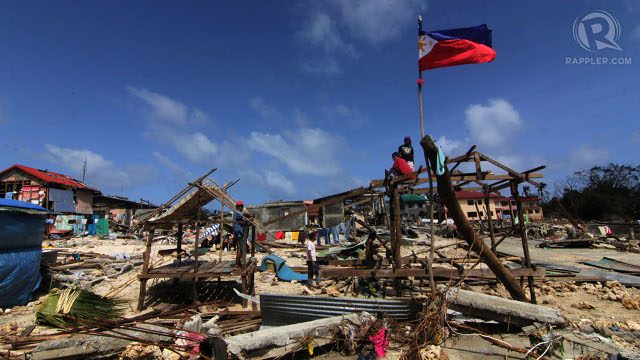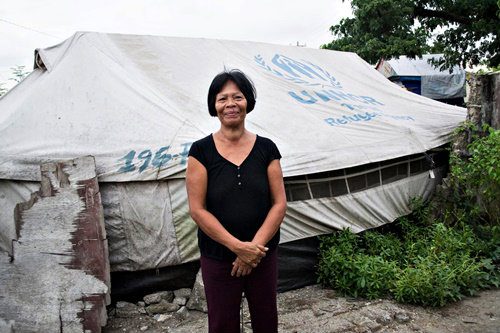SUMMARY
This is AI generated summarization, which may have errors. For context, always refer to the full article.

November 8, 2013
We have come to a time of remembering, a year after the tragic Super Typhoon Yolanda (international name Haiyan) ravaged the Visayas. On this day last year, about 4 million lost their homes, 6,300 people died, 28,626 people were injured and 1,785 others went missing from an unprecedented tragedy that happened in an instant.
The aftermath
I remembered the first walk I had on the streets of Tacloban City shortly after the water from our place receded. I was wearing unpaired slippers I just saw hanging on someone’s wrought iron fence.
When I reached the highway, I saw dead bodies being retrieved from the rubble, lifted towards the lane and wrapped in blankets, campaign posters, and tarpaulins.
I saw a lifeless child placed inside a sack with his head protruding, bloated and unrecognized, just beside a warped car.
A few days after, I saw two dead bodies floating under San Juanico Bridge. In fact, I saw dead bodies arranged in a row, their feet starting to decompose. The struggle of choice in finding missing loved ones among the dead or the living was real. I saw it. I was there. And regardless of how many times I puked at the sight, I know it matters.

Most trees and plants suddenly disappeared. Almost all houses were roofless, flattened, and destroyed. Dead pigs, dogs, cats and other animals were scattered everywhere.
Few vehicles were able to pass the roads because of the piles of debris. Because of the loss of Internet connection and communication signal, people walked and crossed the distance just to ensure the safety of their loved ones.
A few days following Yolanda’s landfall, survivors kept looking for food to eat and health aid for their injuries. Others kept walking in the hope of finding their lost family members, relatives or friends. Many kept wandering, trying to find their way to get out of the devastated place.
Ships landed near the streets, pressing houses down. Establishments were torn while most malls bled. The looting fiasco became a way of coping for some, but it was a serious offense for others. There was anarchy in the streets. What I witnessed seemed like an apocalypse I never imagined experiencing firsthand.
And I’d never forget the nights of deafening silences, filled with indescribable stench of the dead and decomposing bodies. I will always remember the nights spent sleeping beside rusty knives for fear of thieves, escaped convicts, and what the human mind can possibly conceive in desperate times.
Modern-day heroes
Even before the situation got worse, our modern day heroes came to the rescue. While the country played the timeless local and national blame game, international associations, nongovernmental organizations (NGOs), foreign militaries, and the private sector started to move and deploy their people to bury the dead and provide the survivors with the basic needs.
There are about 65 such organizations in Tacloban City and over 200 on the island of Leyte according to local authorities. Even until now, I can still see most of their tents pitched in the ground. I can still spot most of their members around.
The people of Tacloban are thankful for their unwavering support. These organizations provided shelters, personal hygiene kits, cash allowance, relief goods, clothing and medical delivery – things we badly needed in the aftermath of the storm. Cash donation pledges and actual cash donations in various denominations and currency poured in as a united global display of sympathy, compassion and understanding.
What we received from the international and local non-governmental agencies came as both unexpected and remarkable – the kind of assistance that we hoped we had received from our own breed and flesh but unfortunately didn’t. Their language, race, culture, and nation are different from ours but they understood the devastation more than ever.
A year after Yolanda, we remember everyone who extended their support. We thank them on this solemn day for their incredible help.
The reality for some

A year, indeed, has passed since Haiyan wreaked havoc. Some claim that the ongoing rehabilitation process could be considered “impressive.” But if you ask some residents of San Jose, Tacloban City, who still reside in tents and makeshift houses, they will definitely disagree.
Salome Lacaba, 59, still lives in a tent in Barangay 88 with her 3 sons. All their things are already packed in a sack. They are more than ready to transfer into a safer and more comfortable place. She said she often gets sick because there is no proper ventilation inside the tent. She only keeps a solar lamp at night.
Lyling Samarro is a 17-year-old mother to a 5-month old baby girl, LJ. Her husband works as a construction worker. They are among the many families who have not yet been relocated to temporary shelters. Samarro lost count of the times they were informed of a resettlement and of its postponement. Next to the tent given to them is a makeshift house they have constructed.
Their tents are located only a few meters away from the tent that was accidentally destroyed by fire and caused the death of a mother and 6 of her children on May 28. I thought that the fire that caused the deaths of the 7 Yolanda survivors should have alarmed our beloved officials. But it appeared that even after a year, the need to relocate the other remaining families like Salome’s and Lyling’s into bunkhouses or temporary shelters still remained unnoticed.
There is a peal of reality when a hundred survivors like us are asked about the government and what they did to be of help. We will tell you stories of how we were helped by the NGOs and private sectors but definitely not or only a little of the government.
Our families worked very hard to cope, endure and survive and there’s no denying the resilience of Yolanda surivvors. The resilience of the government and its capability to respond to high impact disaster, however, remains questionable.
To my fellow survivors
On its first anniversary, the world joins the Waraynons in remembering the dead and the missing, in honoring those who have extended their love, support, and care for us and our loved ones and in treasuring the second life we have received.
It is never easy to forget about a lost family member, relative, or friend. Those they left behind continue to suffer in grief with wounds still fresh and irreparable. Every single day, they remember Haiyan like no other, wishing that it never happened.
But no matter how painful it is to look back as we remember our own stories of survival and heartaches, we must keep an eye forward. The scars will always be there but that should not stop us from moving on and building back better.
We light our candles of hope, faith, gratefulness, and love. We light our candles because just like the burning flame, our yearnings, hopes and dreams are refined. We light our candles believing that for this very moment, we will gather together as one and give in to illusion that indeed, we are one because that’s what we hope to be.
We light our candle because it’s the time of the year when we remember again. –Rappler.com
Jene-Anne Pangue is a medical laboratory science student of St Scholastica’s College Tacloban. She is also the former editor-in-chief of their student publication, Sulhog Binhi. She thinks that there is a sense of purpose in telling the untold stories of those whose voices are suppressed
For Rappler’s full coverage of the 1st anniversary of Super Typhoon Yolanda (Haiyan), go to this page.
Add a comment
How does this make you feel?
There are no comments yet. Add your comment to start the conversation.